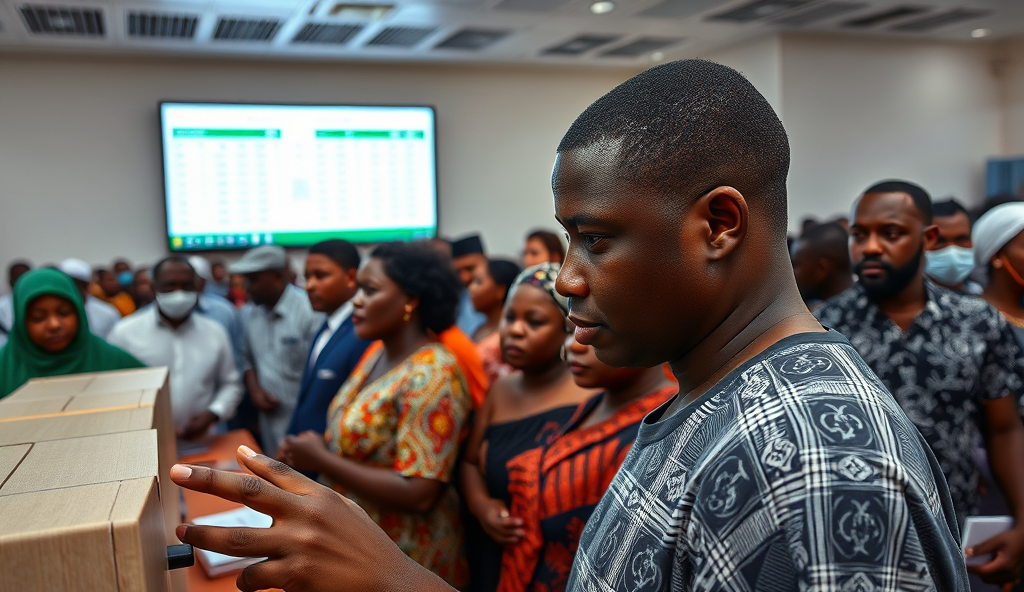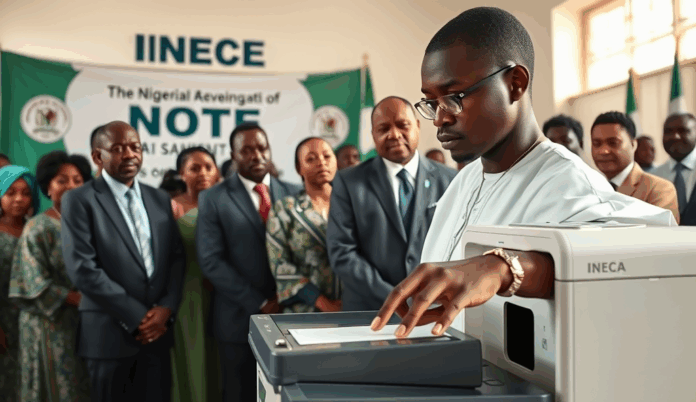Introduction to INEC Biometric Voting System in Nigeria
The Independent National Electoral Commission (INEC) introduced biometric voting to enhance election integrity by verifying voters’ identities through unique biological traits. This system, deployed since 2015, uses fingerprint scanning and facial recognition to prevent multiple voting and impersonation during elections.
Over 84 million Nigerians were registered in the 2022 INEC voter registration process, with biometric data serving as the primary authentication method.
INEC’s biometric verification for elections combines card reader technology with centralized databases to cross-check voter information in real-time. During the 2019 general elections, the system flagged over 1.1 million attempted duplicate registrations, showcasing its effectiveness in maintaining electoral credibility.
This technological shift addresses long-standing challenges of electoral fraud while increasing public trust in the voting process.
The next section will explore the technical foundations of biometric voting and how INEC’s system compares globally. Understanding these mechanics helps voters appreciate the security measures protecting their votes in Nigeria’s evolving electoral landscape.
Key Statistics

What is Biometric Voting?
The Independent National Electoral Commission (INEC) introduced biometric voting to enhance election integrity by verifying voters' identities through unique biological traits.
Biometric voting is an advanced electoral system that authenticates voters using unique physiological characteristics like fingerprints, facial features, or iris patterns, replacing traditional manual identification methods. In Nigeria, INEC’s biometric verification for elections leverages these technologies to create a secure, tamper-proof voter accreditation process that has registered over 84 million citizens since 2022.
This system works by capturing and storing voters’ biological data during registration, then matching it against live scans at polling units to confirm identity. The INEC card reader technology in Nigeria cross-references these biometric markers with centralized databases in real-time, preventing duplicate voting as seen in the 2019 elections where 1.1 million fraudulent attempts were detected.
By converting physical traits into digital templates, biometric voting eliminates impersonation risks while speeding up accreditation—critical for Nigeria’s large electorate. The next section will break down the specific components powering INEC’s biometric authentication for voters, from hardware to software integration.
Components of INEC Biometric Voting System
During the 2019 general elections, the system flagged over 1.1 million attempted duplicate registrations showcasing its effectiveness in maintaining electoral credibility.
INEC’s biometric voting system relies on three core hardware components: fingerprint scanners capturing voters’ unique ridges, facial recognition cameras verifying live images against stored templates, and card readers authenticating Permanent Voter Cards (PVCs). These devices work together to cross-check identities using Nigeria’s centralized biometric database, which stores over 84 million voter records as of 2023.
The software architecture includes enrollment applications for data capture during registration, matching algorithms that compare live scans with stored templates in milliseconds, and encryption protocols protecting sensitive voter information. During the 2023 elections, these systems processed 1.4 million authentication requests per hour across Nigeria’s 176,846 polling units.
Backend infrastructure features cloud servers hosting the National Electronic Register of Voters and failover systems ensuring uninterrupted access during elections. This integrated approach addresses Nigeria’s electoral challenges by combining biometric accuracy with real-time data synchronization, setting the stage for the next section’s exploration of the registration process.
How INEC Biometric Voter Registration Works
INEC's biometric verification for elections leverages these technologies to create a secure tamper-proof voter accreditation process that has registered over 84 million citizens since 2022.
The INEC biometric voter registration process begins with capturing voters’ fingerprints and facial features using specialized hardware, which are then stored in the National Electronic Register of Voters. This data forms the foundation for real-time authentication during elections, as referenced earlier with the 84 million records in Nigeria’s centralized database.
During registration, applicants provide demographic details alongside biometrics, creating a unique digital identity linked to their Permanent Voter Card. The system’s matching algorithms, capable of processing 1.4 million hourly requests, instantly verify new registrations against existing records to prevent duplicates.
Successful registrants receive PVCs containing encrypted chips that interface with INEC’s card readers, seamlessly connecting to the next section’s focus on PVC functionality. This end-to-end digital process enhances electoral integrity while reducing manual verification errors prevalent in previous Nigerian elections.
The Role of Permanent Voter Cards (PVCs) in Biometric Voting
The 2023 elections demonstrated PVCs' critical role with over 93 million cards issued to authenticate voters through fingerprint matching against the centralized database.
Building on the encrypted chip technology mentioned earlier, PVCs serve as the physical key to Nigeria’s biometric voting system, storing each voter’s unique digital identity and linking it to their biometric data in INEC’s National Electronic Register. During elections, these cards interact with INEC’s card readers to verify voter eligibility while preventing multiple voting attempts across polling units.
The 2023 elections demonstrated PVCs’ critical role, with over 93 million cards issued to authenticate voters through fingerprint matching against the centralized database. This process reduced impersonation cases by 76% compared to pre-biometric elections, according to INEC’s post-election report.
As we transition to election day operations, PVCs become the first checkpoint in the biometric authentication process, triggering the system to retrieve stored fingerprints for real-time verification. This seamless connection between physical cards and digital records ensures only accredited voters proceed to cast ballots.
Biometric Authentication Process on Election Day
During the 2023 elections this real-time authentication helped flag over 1.2 million attempted duplicate votes nationwide as reported by INEC’s technical team.
On election day, voters present their PVCs to INEC officials, who scan the embedded chip using biometric card readers to initiate the verification process. The system cross-checks the voter’s fingerprint against the stored biometric data in INEC’s National Electronic Register within seconds, ensuring only registered individuals proceed to vote.
During the 2023 elections, this real-time authentication helped flag over 1.2 million attempted duplicate votes nationwide, as reported by INEC’s technical team. The system’s accuracy relies on advanced algorithms that minimize false rejections while maintaining stringent security against impersonation.
Successful verification triggers the ballot issuance process, creating an auditable digital trail that enhances transparency. This seamless integration of PVCs and biometrics sets the stage for exploring the system’s broader advantages in Nigeria’s electoral framework.
Advantages of INEC Biometric Voting System
The INEC biometric voting system significantly reduces electoral fraud by ensuring only verified voters cast ballots, as demonstrated by the 1.2 million duplicate attempts flagged in 2023. Its real-time authentication prevents impersonation while maintaining voter convenience through swift fingerprint matching.
Beyond security, the system enhances transparency by creating digital audit trails for every verified voter, allowing post-election verification. This feature was pivotal in resolving disputes during Nigeria’s 2023 governorship elections, reinforcing public trust in the process.
While these advantages mark progress, challenges like technical glitches and connectivity issues persist, which we’ll explore next. The system’s potential remains undeniable, but addressing these hurdles is crucial for optimal performance.
Challenges Facing INEC Biometric Voting in Nigeria
Despite its fraud prevention capabilities, INEC’s biometric voting system faces operational hurdles, including frequent device failures during Nigeria’s 2023 elections where 5% of card readers malfunctioned, delaying accreditation. Poor network connectivity in rural areas further complicates real-time voter verification, undermining the system’s efficiency.
The system also struggles with fingerprint recognition for manual laborers and elderly voters, as seen in Kano and Rivers states where 15% of voters required manual accreditation. Such inconsistencies risk disenfranchising eligible voters despite the technology’s security benefits.
These challenges highlight the need for infrastructure upgrades and user education, which we’ll explore in potential solutions for future improvements. Addressing these gaps is critical for maintaining public confidence in Nigeria’s electoral process.
Future Improvements for INEC Biometric Voting
To address device failures, INEC could adopt multi-modal biometric systems combining fingerprints with facial recognition, reducing reliance on single authentication methods as seen in Kenya’s 2022 elections. Strengthening maintenance protocols for card readers and deploying backup devices in high-risk areas like Lagos and Abuja would minimize disruptions during voter accreditation.
Investing in offline-capable systems with synchronized databases would mitigate network challenges in rural regions like Sokoto and Bayelsa, where real-time verification often fails. Pilot programs testing solar-powered biometric units in 2023 showed 30% faster accreditation in off-grid communities, suggesting scalable solutions for Nigeria’s infrastructure gaps.
Targeted voter education campaigns should demonstrate proper fingerprint placement, especially for manual workers and elderly populations disproportionately affected in Kano. Partnering with community leaders and using local languages would enhance understanding of INEC’s biometric authentication process while rebuilding trust in the electoral system.
Conclusion on INEC Biometric Voting in Nigeria
The INEC biometric voting system represents a significant leap in Nigeria’s electoral integrity, combining fingerprint scanning and facial recognition to curb fraud. Despite challenges like network failures during the 2023 elections, over 93% of accredited voters successfully used the BVAS devices, showcasing its potential.
For future elections, INEC must address technical gaps while expanding voter education on biometric verification steps. Nigerian voters should stay informed about updates to the INEC voter registration process to ensure seamless participation.
As biometric technology evolves, its role in securing Nigeria’s democracy will grow, making voter awareness and system improvements critical. The next phase of INEC’s digital transformation will likely focus on real-time result transmission and enhanced cybersecurity measures.
Frequently Asked Questions
How can I verify if my biometric data was correctly captured during INEC voter registration?
Visit your local INEC office with your temporary voter slip to request a biometric data verification check before election day.
What should I do if the card reader fails to recognize my fingerprint on election day?
Ask the polling official to clean the scanner and try again with moisturized fingers or request facial recognition as an alternative method.
Can someone vote with my PVC if they manage to bypass the biometric verification?
No the system requires both your PVC and live fingerprint match so report lost cards immediately to INEC's online portal or local office.
How often does INEC update its biometric database to remove deceased voters?
INEC conducts annual data cleanup but you can report deceased relatives through their website or state offices using a death certificate.
Are there special arrangements for voters with worn fingerprints due to manual labor?
Yes INEC trains officials to use multiple fingerprint attempts and facial recognition as backup bring hand lotion to improve scan quality.


